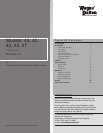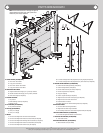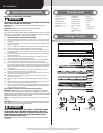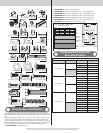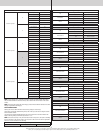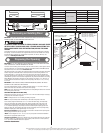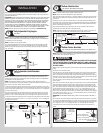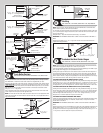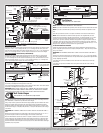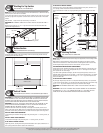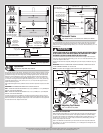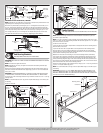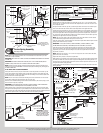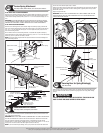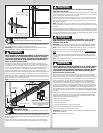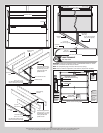
Please Do Not Return This Product To The Store. Contact your local Wayne-Dalton dealer. To find your local Wayne-Dalton dealer,
refer to your local yellow pages business listings or go to the Find a Dealer section online at www.Wayne-Dalton.com
Typical left hand
bottom corner bracket
Bottom section
(1) 1/4” - 14 x 1” Tamper
resistant lag screw
Bottom weather
seal
(3) 1/4” - 20 x 1 7/8” Carriage bolts
and (3) 1/4” - 20 Flange hex nuts
Typical left hand
bottom corner bracket
Bottom section
(1) 1/4” - 14 x 1” Tamper
resistant lag screw
Bottom weather
seal
(3) 1/4” - 20 x 1 7/8” Carriage bolts
and (3) 1/4” - 20 Flange hex nuts
Short stem
track roller
Spacer
Typical left hand
bottom corner bracket
Bottom section
(1) 1/4” - 14 x 1” Tamper
resistant lag screw
Short stem
track roller
Roller
spacer
(3) 1/4” - 20 x 1 7/8” Carriage bolts
and (3) 1/4” - 20 Flange hex nuts
Bottom
weather
seal
Counterbalance
lift cable
Milford pin
Cable loop
Typical left hand
bottom corner bracket
Bottom section
(1) 1/4” - 14 x 1” Tamper
resistant lag screw
Short stem
track roller
Roller
spacer
(5) 1/4” - 20 x 1 7/8”
Carriage bolts and (5)
1/4” - 20 Flange hex
nuts
Bottom
weather
seal
Counterbalance
lift cable
Milford pin
Cable loop
Track Roller Carriers
Tools: Power Drill, 9/32” Drill Bit, Socket Driver 7/16”, Wrench 7/16”
5
NOTE: If you don’t have track roller carriers, then skip this step. Refer to Package Contents /
Parts Breakdown, to determine if track roller carriers were supplied with your door.
Starting on left hand side of the bottom section, attach the track roller carrier with the stamp
“STD” facing UP to the bottom corner bracket by aligning the four holes of the track roller
carrier with the four holes in the bottom corner bracket. Mark and pre-drill (4) 1/8” diameter
holes and secure the track roller carrier to the bottom corner bracket and bottom section
using (4) 1/4”-14 x 1” lag screws.
Insert a short/long stem track roller and spacer into the inner/outer holes of the track roller
carrier. Repeat the same process for the right hand side.
NOTE: The track roller carrier’s inner holes are used on doors with 2” track applications with
a short stem track roller; the outer holes are used on doors with 3” track applications with a
long stem track roller.
Short stem
track roller
Spacer
(4) 1/4”-14 x 1”
Lag screws
Track roller
carrier
Typical bottom
corner bracket
“STD”
facing UP
Long stem
track roller
Side view of track roller
carrier(s)
Inner holes
(2” Track)
Outer holes
(3” Track)
Strutting
Tools: Power Drill, 1/8” Drill Bit, Socket Driver 7/16”, Tape Measure
6
NOTE: Refer to the Door Section Identification and Strut Identification, to determine if the
bottom section requires a short strut to be installed.
Lay the short strut onto the bottom rail of the bottom section. Position the bottom of the strut
3/4” up from the bottom edge of the bottom section. Center the short strut from side to side
on the section surface.
Drill pilot holes, 1” deep into the bottom section using a 1/8” drill bit.
IMPORTANT: BE EXTREMELY CAREFUL NOT TO DRILL THRU THE SECTION. ONLY DRILL 1”
DEEP.
Attach the strut using (2) 1/4”-14 x 1” lag screws at each on each end and center stile
(aligned with hinges) locations.
1/4” - 14 x 1”
Lag screws
Short
strut
3/4”
Typical bottom
corner bracket
Bottom
section
Graduated End And Center Hinges
Tools: Power Drill, 1/8”/9/32” Drill Bit, Socket Driver 7/16”, Tape
7
NOTE: Refer to the Door Section Identification, Graduated End Hinge and Strut Identification,
to determine the appropriate hinges and or struts for your sections.
Using the appropriate graduated end hinges for the ends and depending on the width of your
door, enough center hinge(s) for each pre-drilled hole location.
Starting at the upper left hand corner of the bottom section. Position the lower hinge leaf of
the appropriate graduated end hinge onto the upper corner of the bottom section. Align the
slots of the lower hinge leaf with the pre-drilled holes or the factory installed threads in the
bottom section. Next, lay a long strut (if applicable) over the lower hinge leaf and over the top
rail of the bottom section. Center the long strut from side to side, as shown.
FOR SINGLE GRADUATED END HINGES WITHOUT A STRUT:
Starting on the left hand side, attach the upper slot of the graduated end hinge to the bottom
section using (1) 1/4”-20 x 1-7/8” carriage bolt and (1) 1/4”–20 flange hex nut. Next, secure
the lower slot of the graduated end hinge to the bottom section using (1) 1/4”-20 x 1-7/8”
carriage bolt and (1) 1/4”–20 flange hex nut, as shown. Repeat same process for other side.
FOR SINGLE GRADUATED END HINGES WITH A STRUT (IF APPLICABLE):
Starting on the left hand side, attach the upper slot of the graduated end hinge, (1) strut clip
and the upper leg of strut to the bottom section using (1) 1/4”-20 x 1-7/8” carriage bolt and
(1) 1/4”–20 flange hex nut. Next secure the bottom leg of strut, the lower slot of the gradu-
ated end hinge to the bottom section (1) 1/4”-20 x 1-7/8” carriage bolt and (1) 1/4”–20
flange hex nut, as shown. Repeat same process for other side.
FOR DOORS WITH DOUBLE GRADUATED END HINGES:
Position the second graduated end hinge next to the first (single) graduated end hinge. Using
the second graduated end hinge as a template, drill pilot holes, 1” deep into the bottom
section with a 1/8” drill bit.
IMPORTANT: BE EXTREMELY CAREFUL NOT TO DRILL THRU THE SECTION. ONLY DRILL 1”
DEEP.
Attach the upper leg of strut (if applicable) to the upper slot of the graduated end hinge to the
bottom section using (1) 1/4”-14 x 1” lag screw. Next secure the bottom leg of strut (if ap-
plicable) to the lower slot of the graduated end hinge to the bottom section using (1) 1/4”-14
x 1” lag screw, as shown. Repeat same process for other side.
8



